Ten typical aquarium fish for beginners and alternatives to them
Table of contents
- What is a beginner fish anyway?
- General information
- 12 popular aquarium fish and alternatives that you haven't seen in 100 other aquariums yet
- The Guppy (Poecilia reticulata)
- The Endler Guppy (Poecilia wingei)
- The Antenna Catfish (Ancistrus sp.)
- The Queen Arabesque Catfish (Hypancistrus sp.)
- The Zebra Tree Finch (Brachydanio rerio)
- The Leopard Cichlid (Brachydanio frankei)
- The Spotted Catfish (Corydoras punctatus)
- The Gold Laser Corydoras (Corydoras sp.)
- The Panda Corydoras (Corydoras panda)
- The Miguelito Corydoras (Corydoras virginiae)
- The Red Neon (Paracheirodon axelrodi)
- The Cardinalfish (Tanichthes albonubes)
- The Sparkling Tetra (Hyphessobrycon amandae)
- The Copper Tetra (Hasemania nana)
- The Sumatran Barb (Barbus tetrazona)
- The Odessa Cormorant (Puntius padamya)
- The Magnificent Loach (Botia macracantha)
- The Checkered Loach (Yasuhikotakia sidthimunki)
- The Molly (Poecilia sphenops)
- The Sailfish (Poecilia velifera)
- The Fighting Fish (Betta splendens)
- The Peaceful Fighting Fish (Betta imbellis)
- The Platy (Xiphophorus maculatus)
- The Swordtail (Xiphophorus helleri)
- Finally
What is a beginner fish anyway?
Defining what is the best fish for a beginner in aquaristics is not quite easy. Basically, it always depends on the conditions in the aquarium. For example, a fish that is difficult to keep in hard water and impossible to breed can be absolutely suitable for beginners in soft water - lucky for you if the water comes out of the tap with the right values!
Furthermore, one should distinguish between keeping and breeding - many tetras, such as the well-known red neon, for example, can be kept excellently in soft to hard water and also grow old there, but breeding only works in very soft water. So what can be a wonderful starter fish for a pure keeper can drive a breeder who is not suitably experienced to despair.
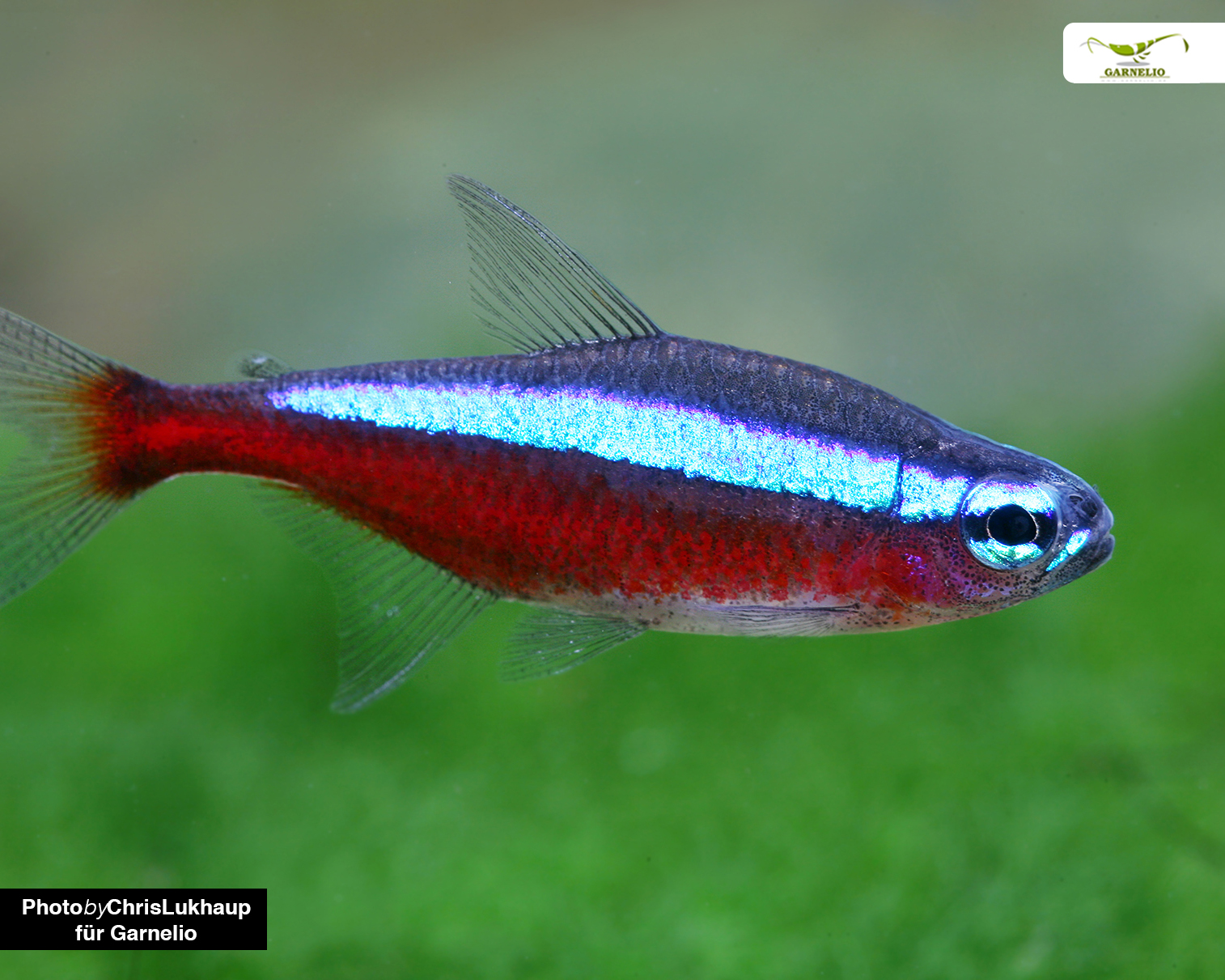
General
Even if the description "beginner fish" or "easy to keep" sounds a bit like an aquarium inhabitant that is forgiving of just about anything, one should nevertheless not get carried away with sloppiness. Even the so-called robust, adaptable beginner fish deserve animal-friendly husbandry and the greatest possible attention! It cannot be an excuse not to take good care of the aquarium, because the inhabitants can take quite a bit of stress.
Aquarium size
The right aquarium size is especially important for beginners. We give recommendations on the right aquarium size for every fish species we offer in the Garnelio Online Shop, and for schooling fish also on the recommended schooling size. Keeping group fish individually is not animal-friendly. If the aquarium is smaller than recommended, it is not an option to keep just one Platy.
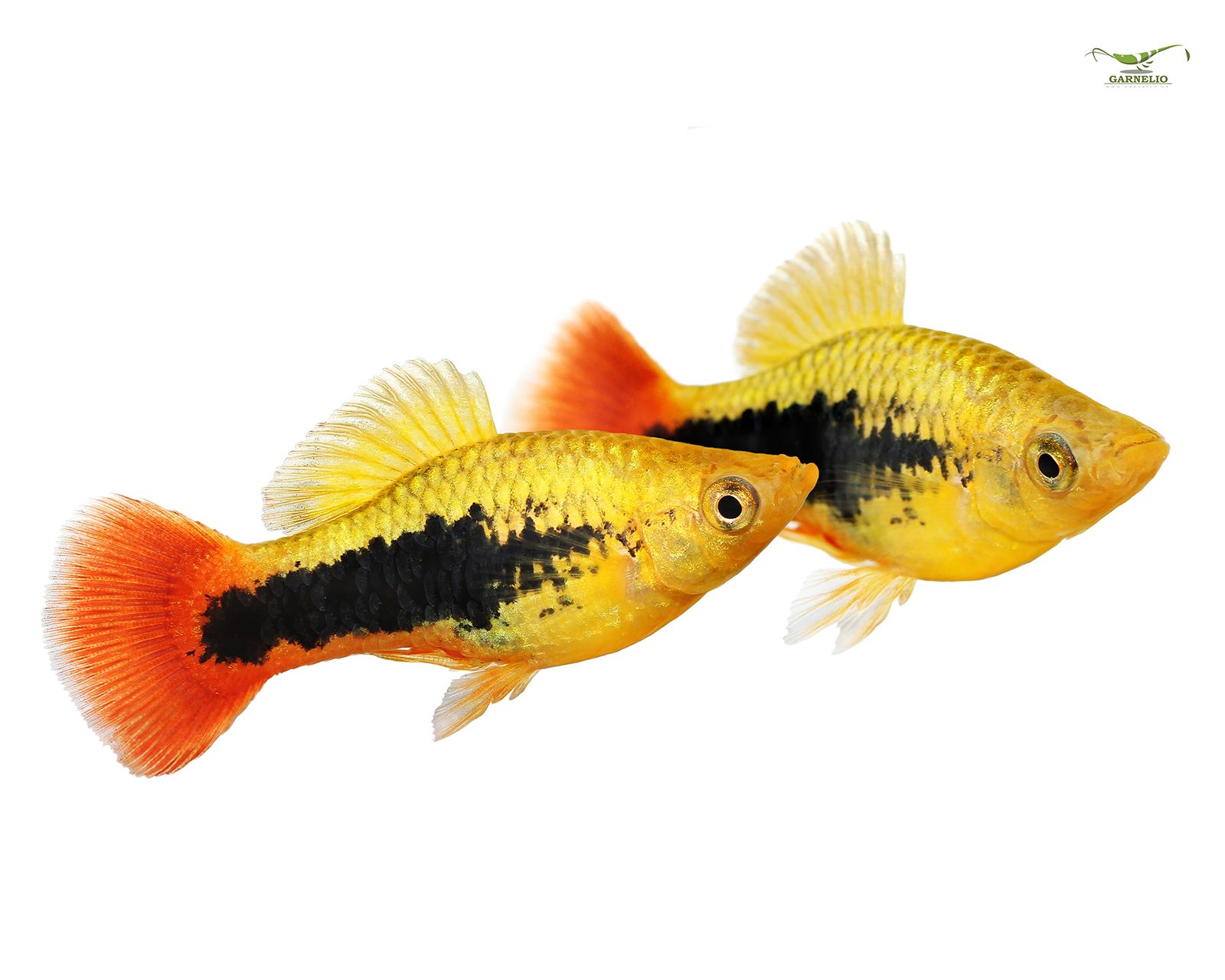
"Fish soup" - good or bad?
A colourful mixture, two of these, three of these, and one of that, does not usually meet the needs of the animals either - and sometimes our human sense of aesthetics simply has to take a back seat. Please avoid fish soups - it is nicer for schooling fish to find a larger number of conspecifics, they usually don't get on with other fish that do not belong to the same species.
By no means do we choose fish that match the colour of the furnishings ... the water has to be right, the aquarium size and aquarium furnishings have to meet the needs of the fish, and if the colours also play along, that's the icing on the cake. There are few exceptions here ... of livebearers like guppies, platies or swordtails there are indeed an incredible number of colour varieties, and here you can combine to your heart's content. As long as the colourful species all belong to the same species, the group size in the colourful combination will also work.
Dealing with well-reproducing species
If you choose species that reproduce well - especially the livebearers just mentioned, such as guppies, platies, swordtails and co., but also antennae catfish are notorious in this respect - it is best to think about where to put the offspring, which will almost certainly occur en masse, before you buy them. A colourful mix is counterproductive here - mixes are hard to get rid of and usually end up either in the pet shop (in exchange for a can of food) or as live food. If you want to spare your favourites this fate, either choose only animals of one colour and then breed selectively, or - if you like the candy-coloured mix in the aquarium - limit yourself to keeping only one sex. As a rule, the males are more beautiful, more intense and more colourful, so that an all-male community in the aquarium is particularly suitable for livebearers. At Garnelio we have a separate blog with detailed information on keeping guppies: The Guppy in the Aquarium. The other livebearers such as platies, mollies or swordtails function very similarly, only the demands on the aquarium size vary.

12 popular aquarium fish and alternatives that you haven't seen in 100 other aquariums yet
In the following, we would like to take a closer look at 12 fish that are suitable for beginners and very often recommended for newcomers to the aquarium hobby - and give alternatives to these fish that are just as easy to keep or breed, but which you haven't already seen enough of in a thousand aquariums. It doesn't have to be the same combinations of Neons, Antennae Catfish and Guppies ...
For reasons of space, we have to limit ourselves to a brief characterisation here. You can find more information in the article descriptions, which you can access by clicking on the green highlighted word "Shop" in the respective headings.
However, there are many, many more aquarium fish that are also suitable for beginners! Browse a little in our online shop... the fish suitable for beginners can be recognised at first glance by the classification 1 - easy in the degree of difficulty in the overview of characteristics on the respective product page.

The Guppy (Poecilia reticulata)(Shop)
The Guppy is THE beginner fish par excellence. Robust, easy to socialise, very adaptable, great to keep in aquariums with an edge length of 60 cm or more, and the live-bearing Guppies also reproduce well. There are countless really beautiful colour varieties with intense shades in all colours of the rainbow to buy. The social guppies are omnivorous and need a proportion of plant food for good digestion. They will also eat softer algae genes such as soft filamentous algae or other green algae and are really fun to watch with their lively, inquisitive nature.
If you want to avoid extreme reproduction, choose an all-male group. Keeping them single-sex does not affect the animals' natural behaviour much, on the contrary, these guppies usually even get older than the males from mixed groups because a lot of stress is eliminated. If you want to keep a mixed group, you should know beforehand what to do with the offspring - or put a predator like a tetra group in the aquarium to "take care" of surplus young fish.
Guppies tolerate soft to hard water and have no great demands on the aquarium setup. They do not touch plants and leave the decoration alone.
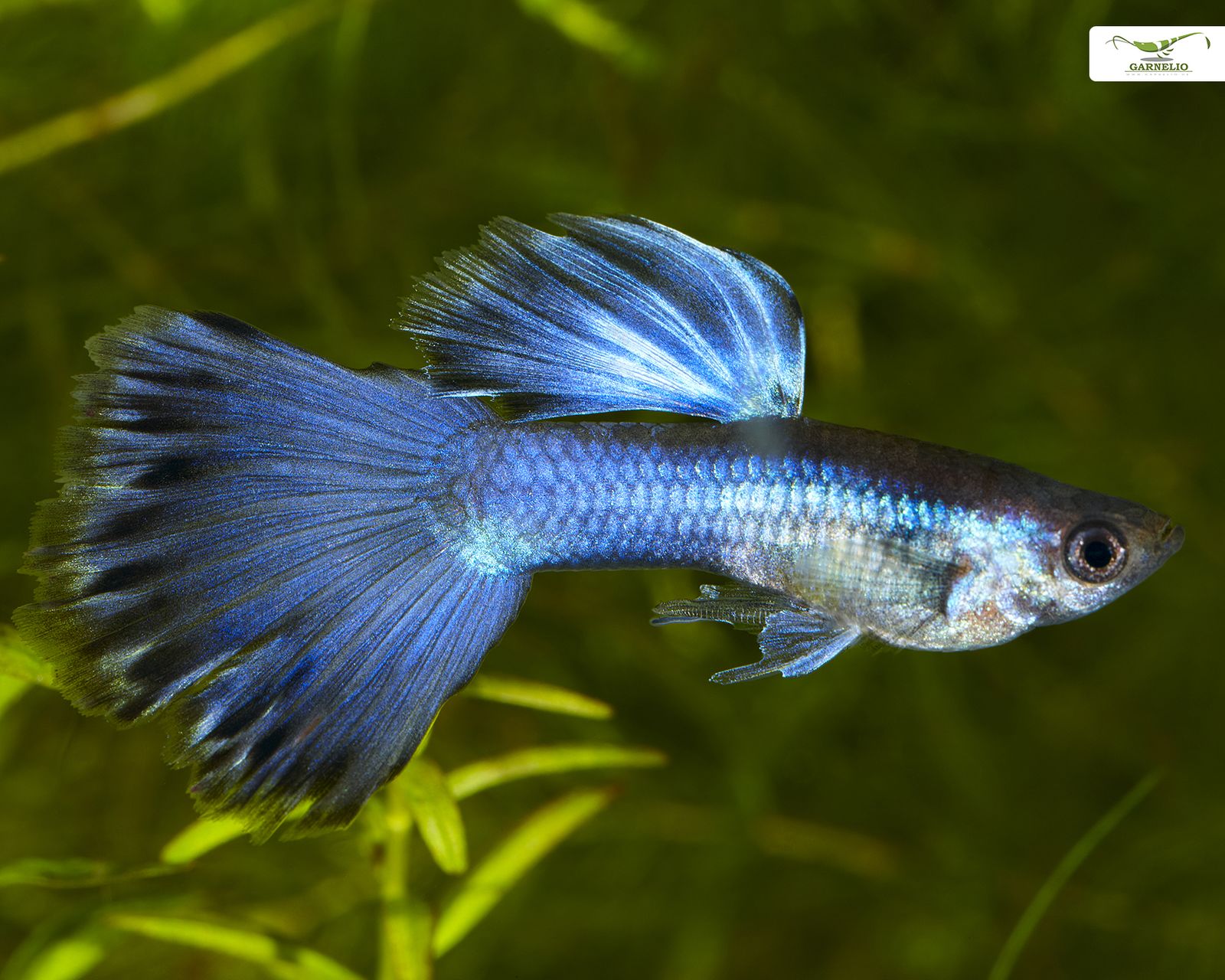
The Endler Guppy (Poecilia wingei)(Shop)
For all those who have had enough of the usual guppies in the aquarium, the somewhat smaller Endler Guppy is a nice alternative. These live-bearing aquarium fish remain somewhat smaller than guppies and are just as robust and suitable for beginners.
Endler guppies need a shoal and are a little less eager to reproduce than guppies, but they still reproduce extremely well in the aquarium. Here, too, keeping an all-male group or keeping them in a community aquarium with other fish such as tetras is a good idea if you want to avoid excessive offspring.
Like the guppy, the endler is not demanding in terms of aquarium setup, gets along very well in soft to hard water and does not eat plants. Endlers also come in a variety of colourful varieties.
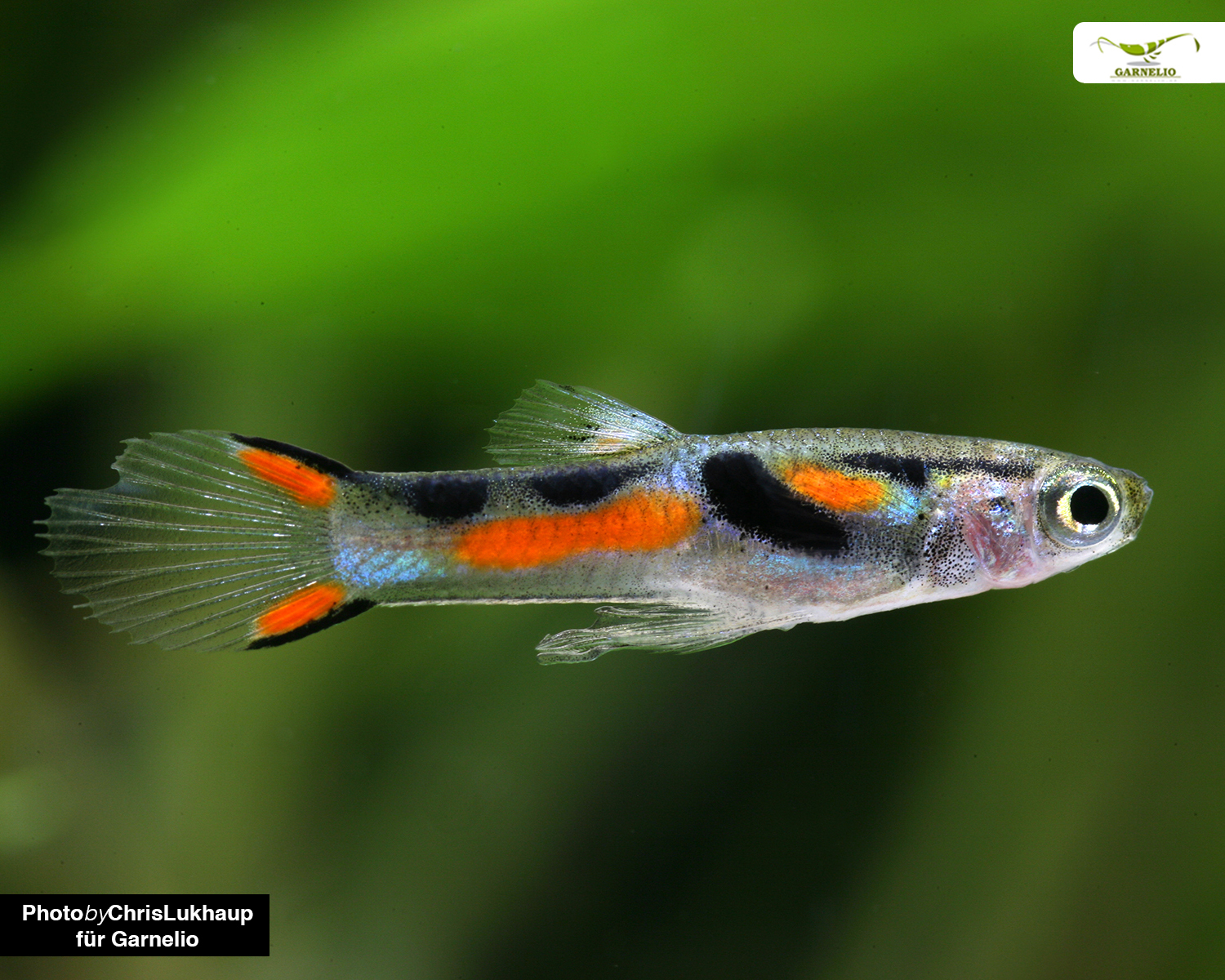
The Antenna Catfish (Ancistrus sp.)(Shop) / The Golden Antenna Catfish(Shop)
Who doesn't know him - the robust pane snooper, pane cleaner, algae cleaner or whatever other affectionate nicknames the antenna catfish has been given? These effective algae destroyers prefer to eat algae deposits from the panes and decorations, keeping them nice and clean. They are peaceful and compatible and fit very well into the usual community tanks. There is probably almost no aquarium without an Antenni ... even if unfortunately many of these useful and, if you look closely, also quite pretty antennae catfish have to languish in tanks that are far too small. The aquarium should have an edge length of 80 cm if you want to keep these ancistras in a species-appropriate way! They can be kept in soft to hard water without any problems.
When kept in pairs, the antennae catfish, which breed in caves, are incredibly productive and it is really difficult to sell the young. Often not even the local pet shop will still take the young Antennas, so keeping them in separate-sex groups is definitely recommended here. Male Antennae Catfish with their impressive antler-like antennae are somewhat territorial, so an aquarium with more than one Ancistrus sp. should be well structured and offer hiding places and caves. The females have a smoother head and are more compatible.
Plants are usually left alone - only with Echinodorus can Ancistrus sp. often not hold on to them. However, if you feed vegetables in the aquarium, you can keep the damage within limits.
In addition to the brown, brightly spotted form, the albino form Golden Antenna Catfish is also in circulation, for which of course the same applies - however, it is usually somewhat easier to get rid of the juveniles of this colour form than the brown ones.
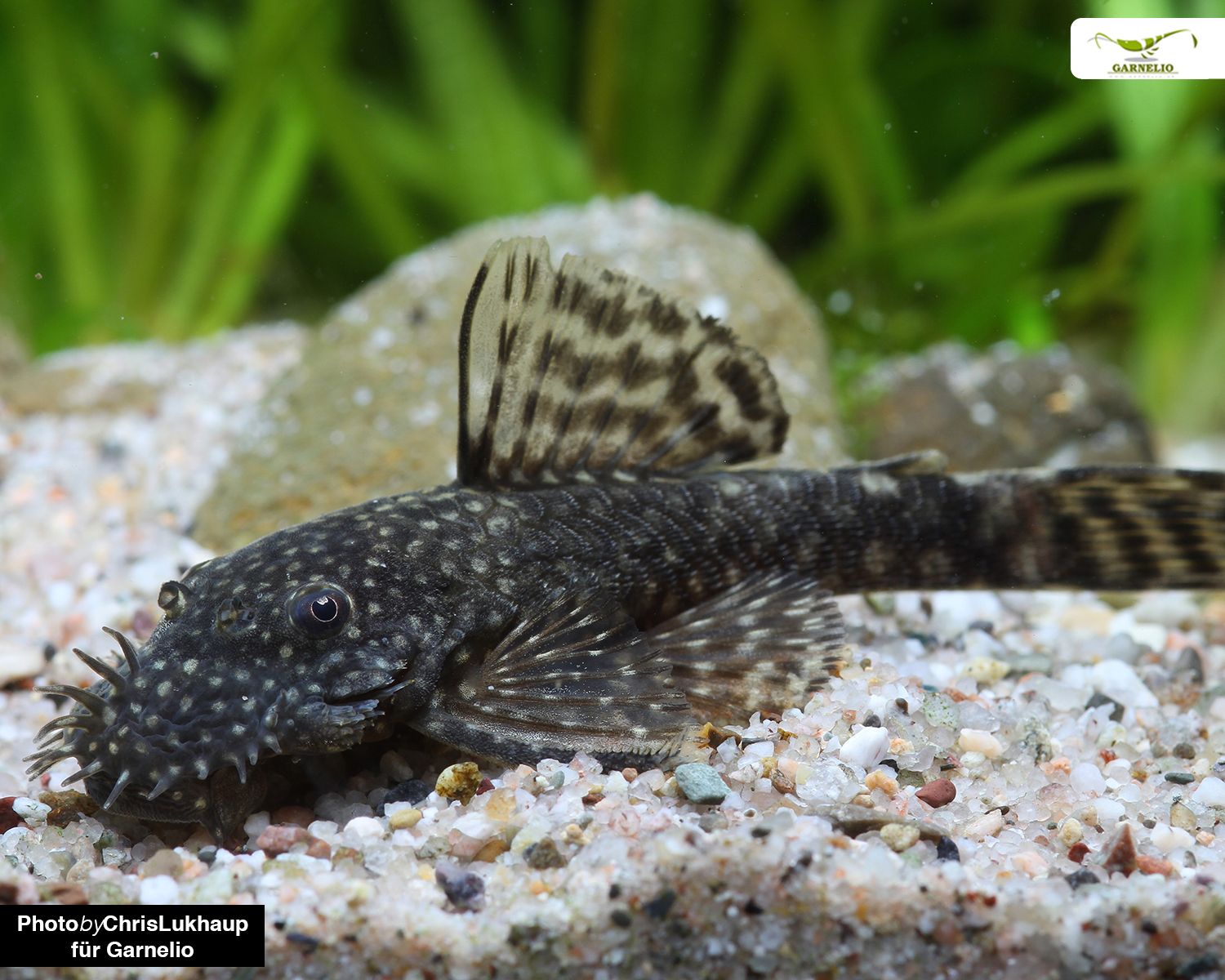
The Queen Arabesque Catfish (Hypancistrus sp.)(Shop)
Just as an example, we would like to mention the L260 Queen Arabesque catfish - one of many, many catfish you can find in our shop at Garnelio. Most of these catfish are just as easy to keep as the Ancistrus sp. (although they are generally not comfortable in very hard water and prefer rather medium hard water).
The Queen Arabesque, which we have chosen as an example, does not like plants as much as the Antenna Catfish and has similar requirements (apart from the slightly lower water hardness, which is tolerated) - only it is much more beautifully marked and is not seen quite as often. Breeding can also be successful even in a community aquarium. The Queen Arabesque is best kept in pairs or in a small group in a sufficiently large aquarium. It is very compatible and compatible with the fish species commonly found in community aquariums and even goes well with shrimp.

The Zebrafish (Brachydanio rerio)(Shop)
Zebrafish are lively, lively schooling fish that have been present in aquaristics since time immemorial and still have a very large fan community today. These danios are adaptable, forgive the occasional fancy water change (although this should not be an excuse ...) and are simply fun to play with. As a social group fish, they absolutely need conspecifics for company. There is also a veil form of Brachydanio rerio with longer fins, but the same applies to this as to the wild form.
These frugal omnivores are perfectly happy with high-quality flake food and also fit perfectly into a planted community aquarium with tetras or guppies (or both, if it is large enough). Breeding in a community aquarium is difficult, but in a separate breeding tank you can start a pair very well and usually have breeding success even as a beginner.
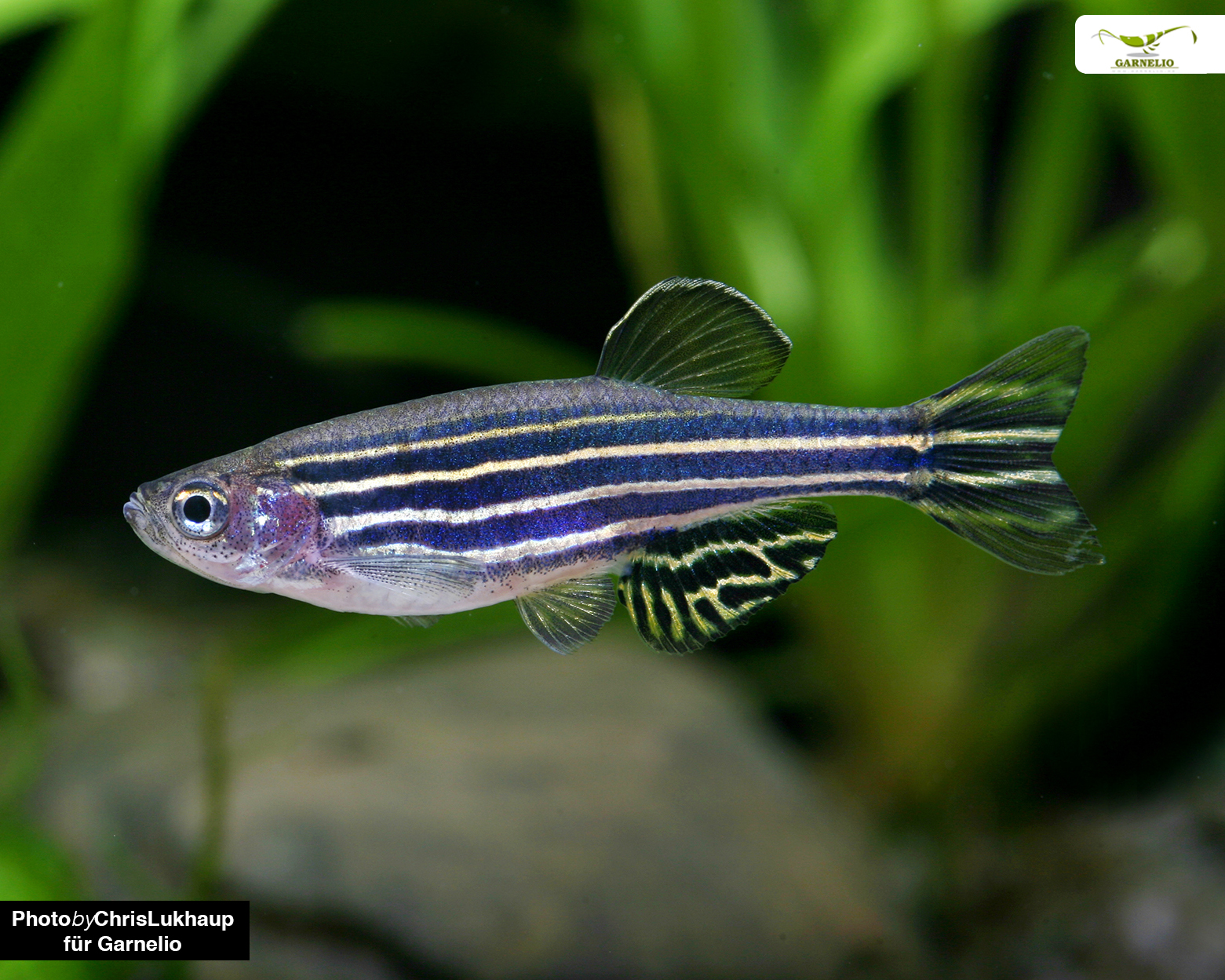
The leopard danio (Brachydanio frankei)(Shop)
It is unclear whether this is really a separate species - the leopard danio looks and behaves like the zebra danio, but instead of stripes it has spots, which gave it its name and make it look a bit like a miniature trout. For those who have had enough of the striped shape, this spotted aquarium fish is a nice alternative. A mixed shoal of leopard danios and zebra danios also works excellently, and the fish even interact.
There is also a veil form of the leopard danio with longer fins.
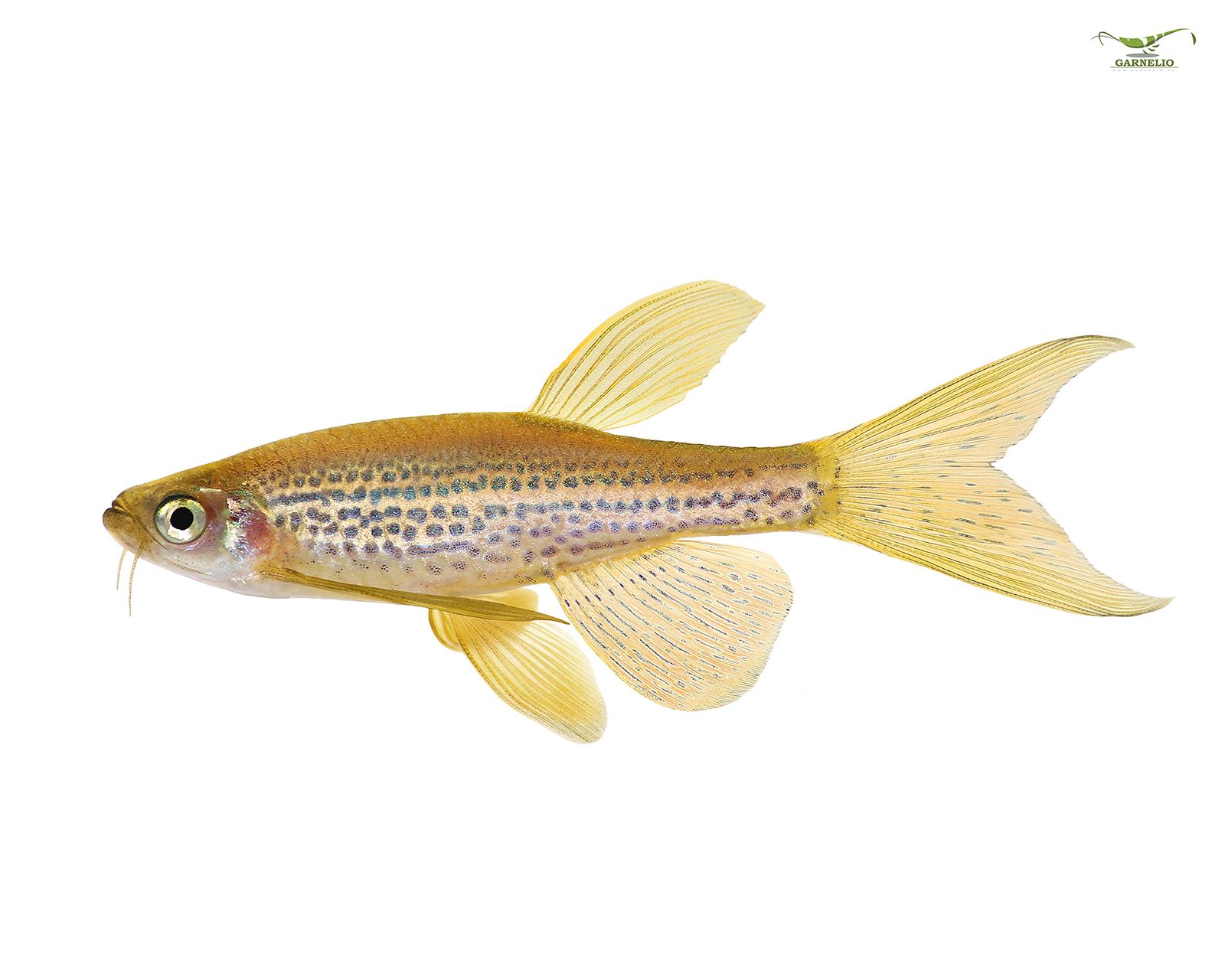
The Spotted Catfish (Corydoras punctatus)(Shop)
The spotted armoured catfish is an evergreen in aquaristics. The small intestinal worms scurry around on the bottom and eat worms and anything else they find. Spotted catfish are lively group fish and charm the observer with their behaviour in the aquarium. If you provide them with a corner of sand, you can watch them burrowing - a really fun way of foraging!
Corys are a bit trickier to breed - this is best done in a separate breeding aquarium - but they can be kept optimally even by beginners in aquaristics. Corydoras punctatus can live in soft to hard water, in aquariums with little to a lot of plants, and they feel comfortable in an aquarium with an edge length of 60 cm or more.
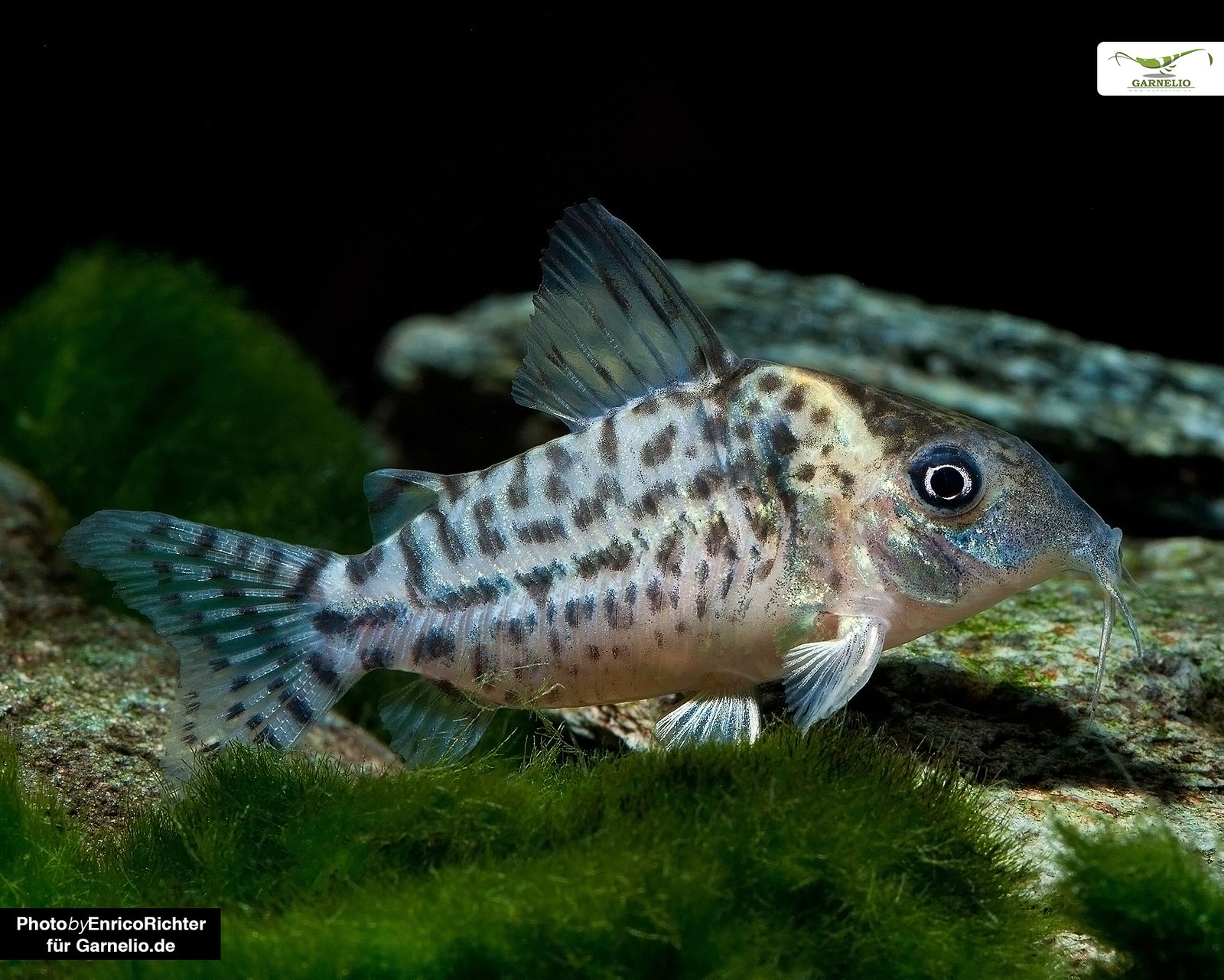
The Gold Laser Corydoras (Corydoras sp.)(Shop)
Everything that applies to the Spotted Corydoras applies to the Gold Laser Corydoras - except that this species is much prettier to look at and not quite as widespread in aquariums. The golden stripes on the back shimmer mysteriously and give these fascinating, scurrying ornamental fish a charm all of their own. With a life expectancy of 8 to 10 years, you will have something from these pretty aquarium inhabitants for a long time.
A group of Gold Laser Corydoras is a perfect choice for anyone who has grown a little tired of the worm line pattern of the usual corydoras common in aquaristics. This Corydoras is also easy to breed, especially in a breeding aquarium under certain conditions.
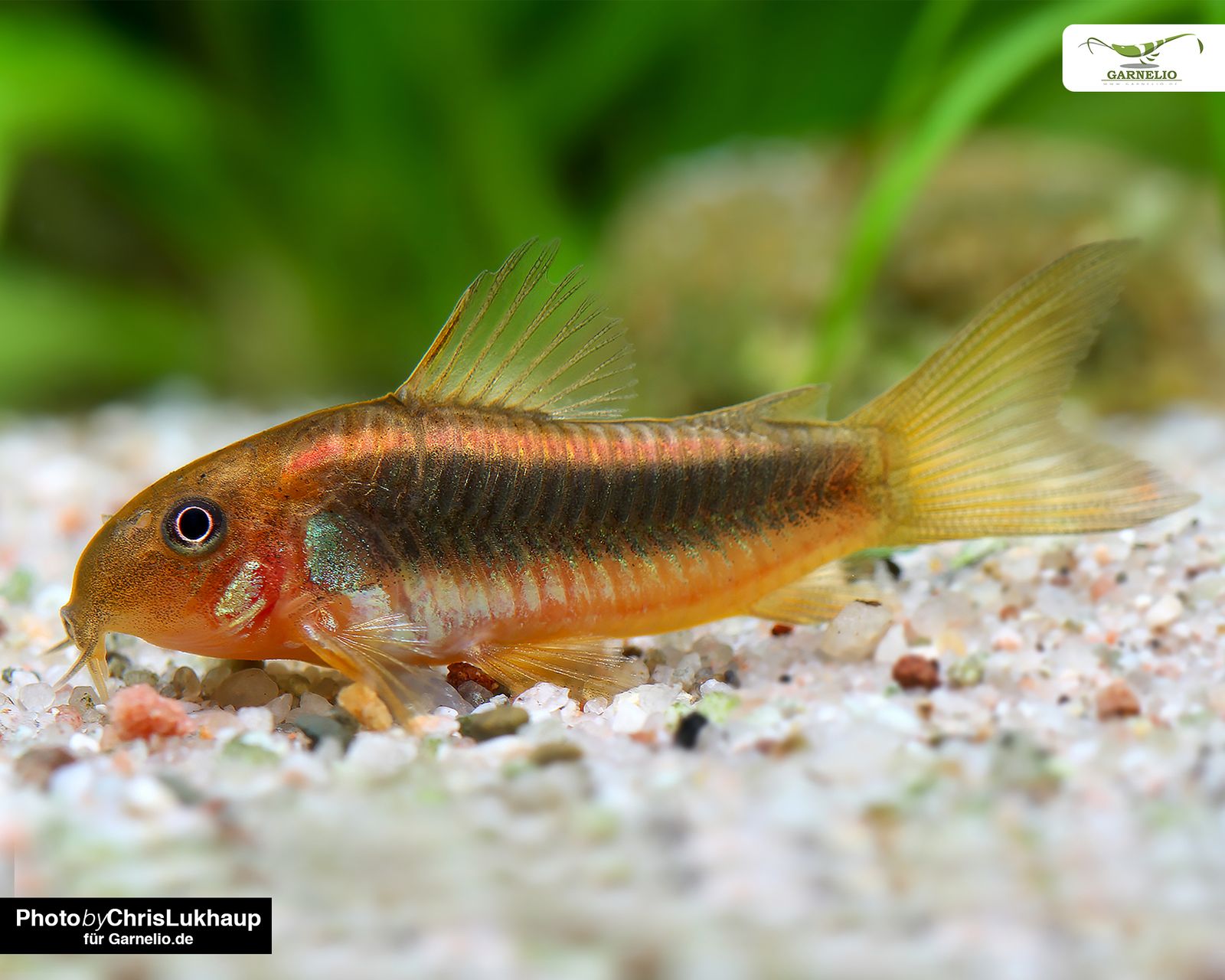
The Panda Corydoras (Corydoras panda)(Shop)
The Panda Corydoras is another well-known Corydoras from the aquarium hobby. Who doesn't know these funny light-coloured creatures with the black spots? Their lively nature and their interaction with other species is really worth seeing, and because these funny little fellows can be kept in soft to rather hard water from as little as 54 litres, they are very popular in the aquarium hobby.
Breeding is not that easy, but under the right conditions it can also work for beginners who have read up on the subject. Panda corys do well in aquariums with little to a lot of plants. They find a sandy corner super, because there they can optimally dig for food.

The Miguelito Corydoras (Corydoras virginiae)(Shop)
Also light coloured with dark spots, but with a different distribution than the so often seen Panda Corydoras and therefore a really good alternative to Corydoras panda is the Miguelito Corydoras. These likeable little wuslers are just as easy to keep as the pandas, and just as great to watch.
Not much is known about breeding, but for a beginner who does not want to breed anyway, they are the perfect alternative to the quite frequently seen Corydoras panda.
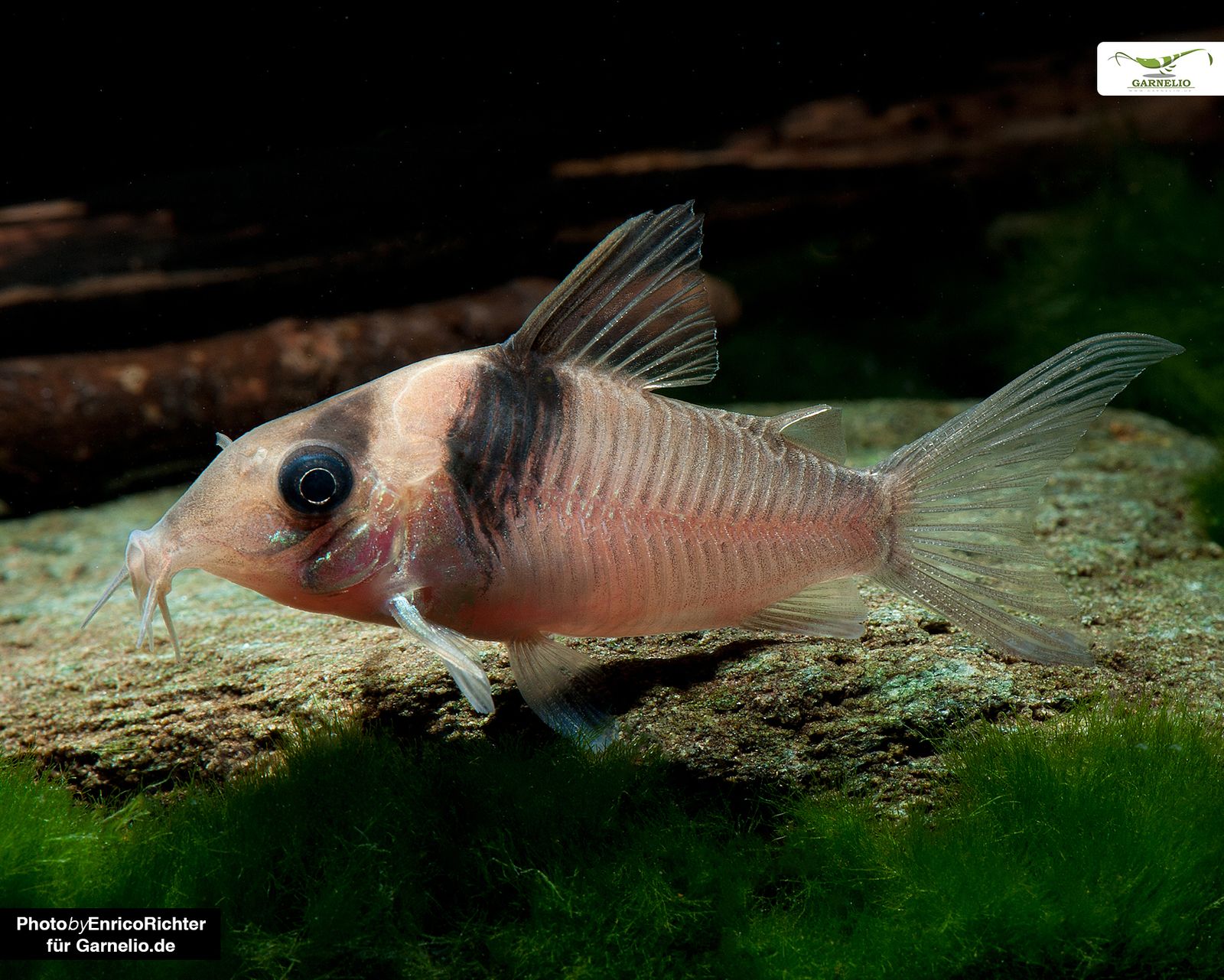
The Red Neon (Paracheirodon axelrodi)(Shop)
Really no aquarium show, pet shop or aquarium fair is complete without these tetras: Red neons are incredibly pretty with their red colour and bright blue stripes. They are not easy to breed, but these omnivores are really uncomplicated to keep and do surprisingly well not only in soft but also in harder water.
Especially in front of green plants, the contrast of colours is simply gorgeous, and a shoal of Red Neons is an ornament for (almost) every aquarium from 54 litres upwards. The "problem" - Paracheirodon axelrodi can really be found in an extremely large number of aquariums and many have really grown tired of them by now.
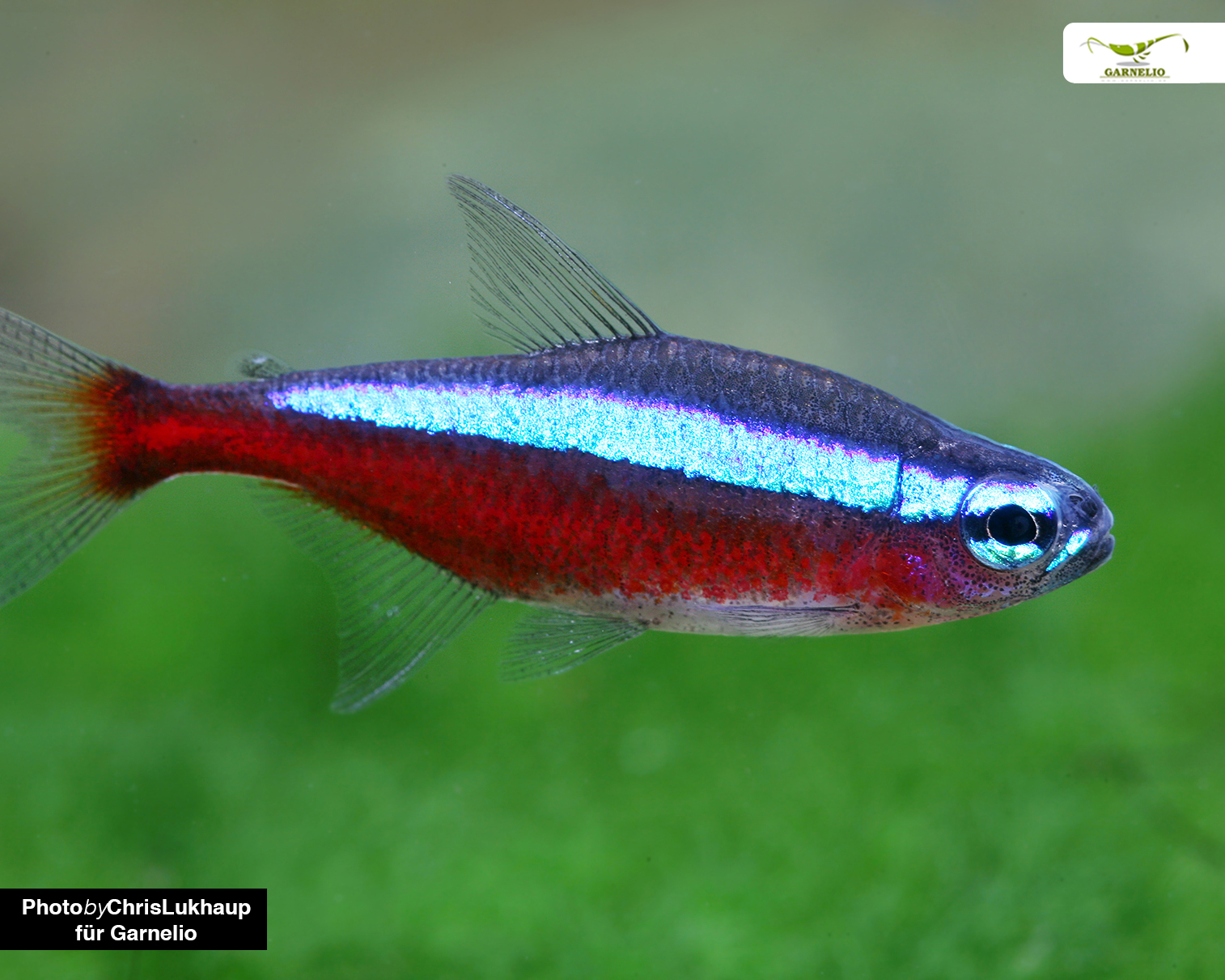
The Cardinalfish (Tanichthes albonubes)(Shop)
The cardinalfish has also been around for a long time in aquaristics, but it plays a rather subordinate role - very unjustly, in our opinion. The fact that nasty tongues sometimes call it a "poor man's neon" is probably due to the fact that a school of cardinalfish can also be kept in an unheated aquarium, in addition to its beautiful red and brilliant white colouring, which is actually quite reminiscent of that of the red neon. It may not like it as warm as the Red Neon, but at room temperature the Cardinalfish usually does very well.
The pretty fish can be purchased in various colour strokes and fin shapes, another thing they have over the Red Neon. They are extremely compatible with other peaceful fish, do not attack plants, and unlike the Red Neon, Cardinalfish are relatively easy to breed. In our eyes, the perfect alternative for unheated aquariums.
The Fire Tetra (Hyphessobrycon amandae)(Shop)
The fire tetra or sparkle tetra is also an old, well-known and often seen fish in aquaristics. It can be kept from 54 litres, soft to medium hard water is ideal for these small fire rays. This tetra can be kept in a shoal in a community tank with other small fish, or together with shrimps, which reproduce well. They definitely feel most comfortable in planted aquariums with swimming space.
Fire tetras are omnivores, but need some frozen food or fine live food from time to time.
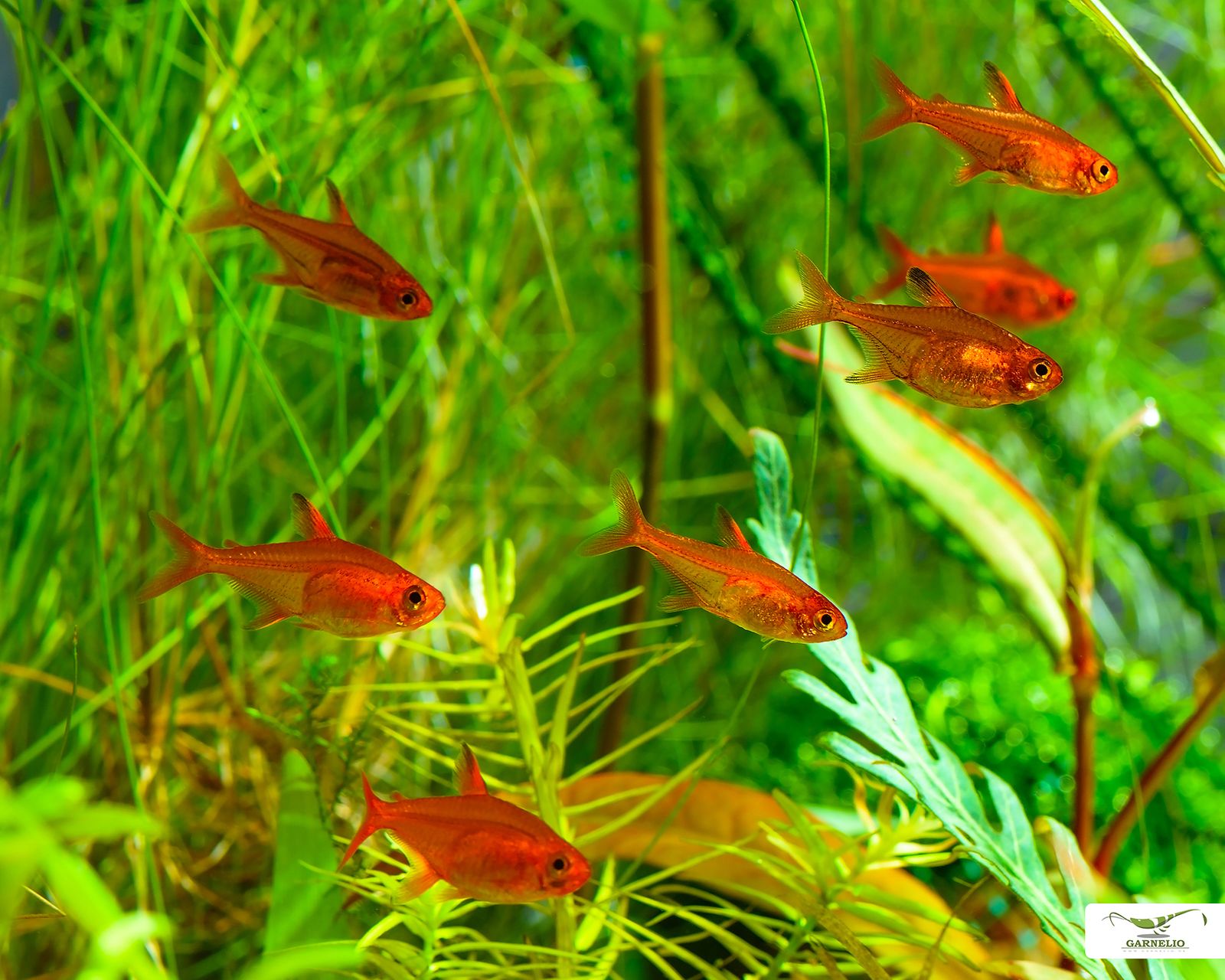
The copper tetra (Hasemania nana)(Shop)
If you are looking for an alternative to the often seen orange sparkling tetra, the small copper tetra might be a good choice. Like Hyphessobrycon amandae, Hasemania nana needs soft to medium hard water. Its lively behaviour can be easily observed in an aquarium with an edge length of 80 cm or more. The somewhat more restrained body colour is spiced up by white luminescent spots at the ends of the fins.
The copper tetra is also easy to socialise with shrimps, which reproduce willingly and in large numbers, and breeding is even easier than with the fire tetra.
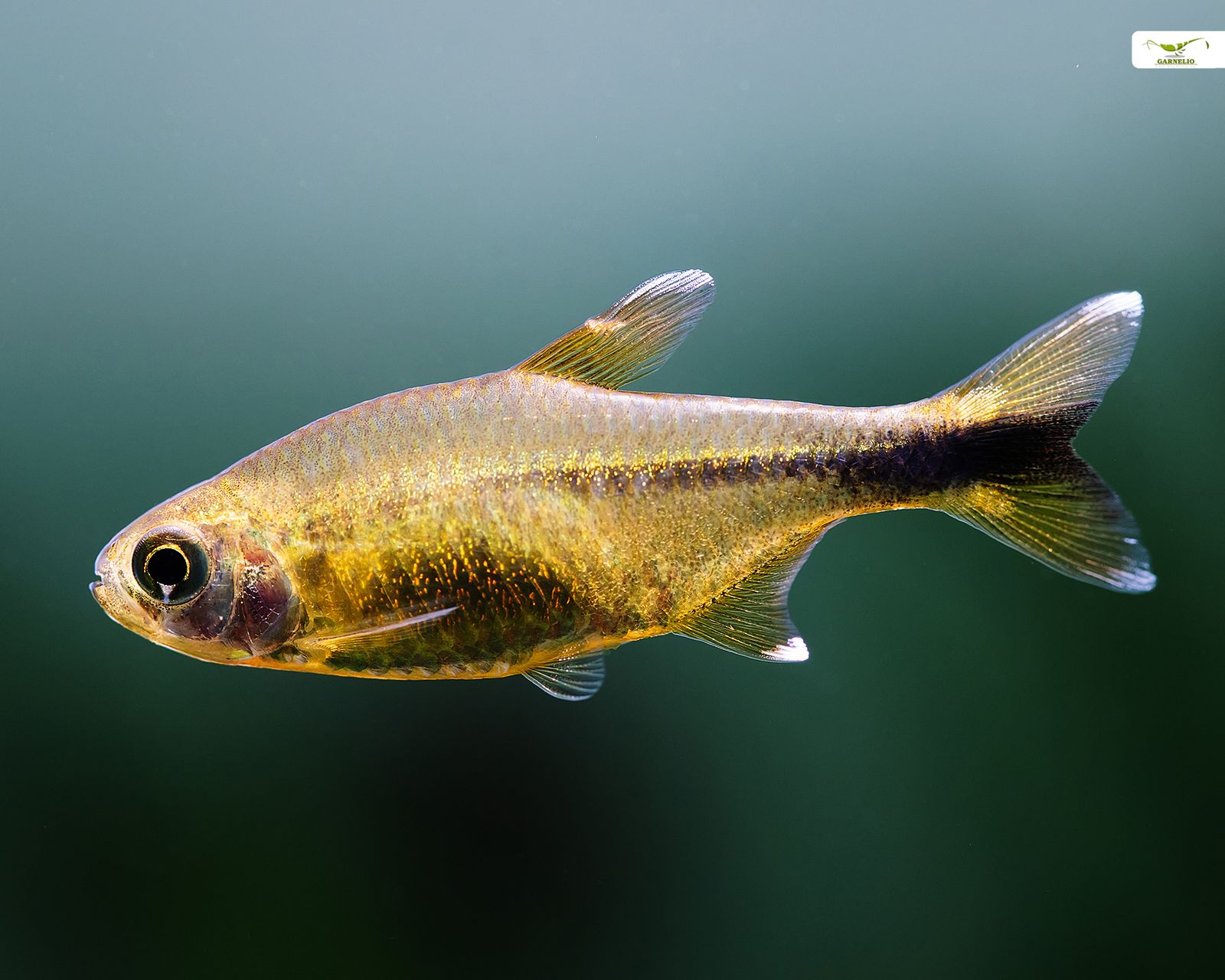
The Sumatran barb (Barbus tetrazona)(Shop)
The striped form of the Sumatran barb is also indispensable in aquaristics. Thanks to their robustness, these gruff, lively little aquarium fish are a highly recommended fish for beginners in aquaristics. They fit well in planted aquariums with soft to hard water, even if they sometimes tug at fine plants. Their territorial fights and their very interesting social behaviour make them super observable aquarium inhabitants. Even beginners can breed the Sumatran barb relatively well in the aquarium. However, the striped form is seen insanely often in the aquarium, and not only one aquarist has gotten a bit fed up with it.
How good that the Sumatran barb even comes with alternatives in its species! They also come in different colour varieties: dark green moss barbs, a golden variety, a golden-blue colour variety and a platinum-turquoise form.

The Odessa Barb (Puntius padamya)(Shop)
If you are looking for an alternative to Barbus tetrazona despite the rich colour selection of Sumatran barbs mentioned above, you might be happy with the Odessa barb. This barb does not even need a heater, is just as interesting in terms of behaviour as the Sumatran barb and can even move into the garden pond in summer.
Breeding the beautifully coloured Odessa barb is also easy and suitable for beginners, and while it is definitely a beginner's fish, it is also a rather rare aquarium guest and thus a great alternative to the really often seen Sumatran barb.
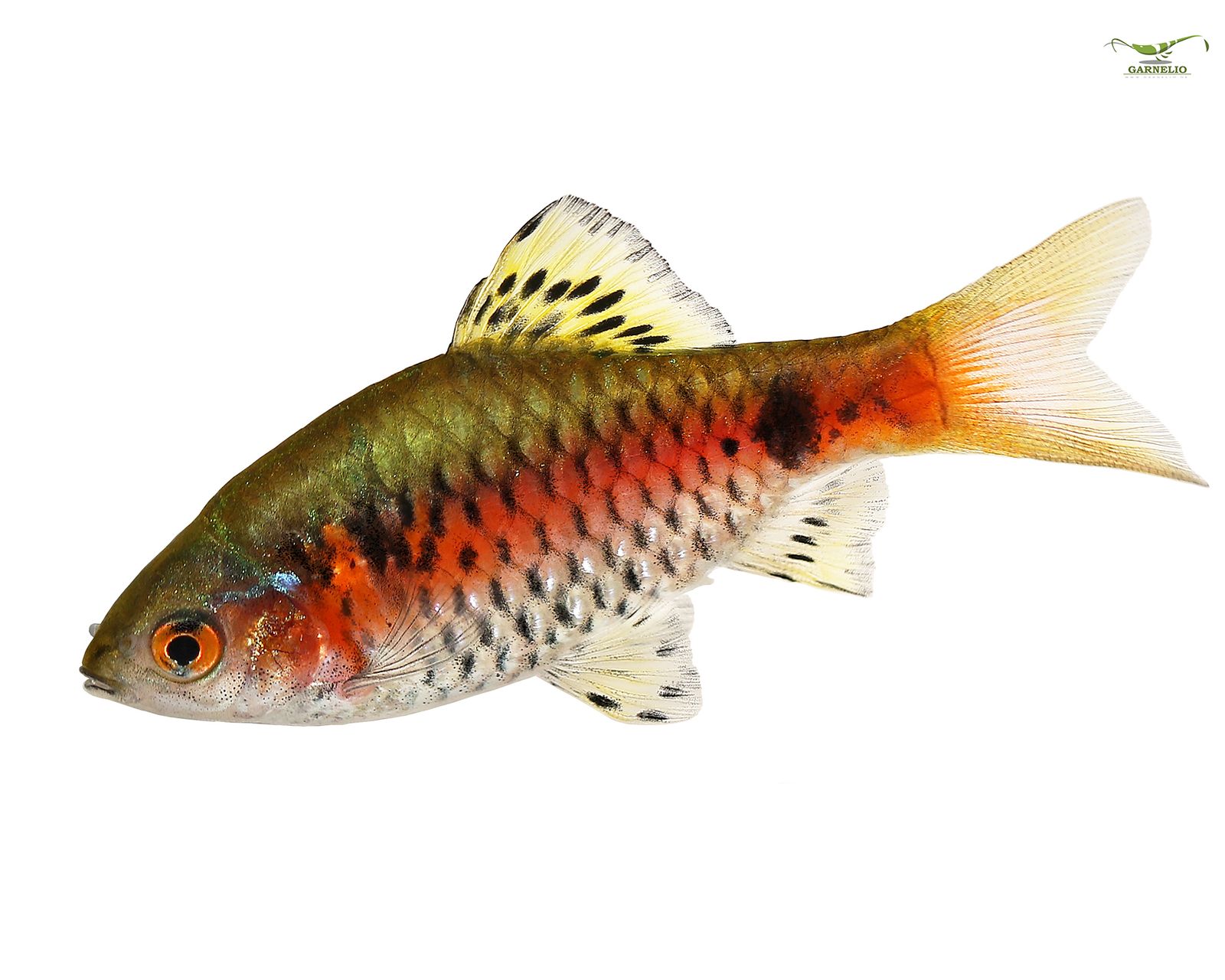
The Magnificent Loach (Botia macracantha)(Shop)
Often crammed into aquariums that are far too small as an effective snail eater, the magnificent loach is rather a victim of its reputation for being an easy aquarium fish. When old, Botia macracantha becomes really huge, up to 30 cm long, so it should be kept in sufficiently large aquariums from the start and never crammed into the typical 60 or 80 cm long beginner's aquarium, no matter how annoying the snail plague may be.
When kept singly, loaches quickly mutate into bullies that terrorise the entire aquarium. In a shoal, on the other hand, they can live out their social behaviour on conspecifics that tolerate it well. Keeping them singly is definitely to be rejected, as is keeping them in an aquarium that is too small, even though one sees enough very sad examples of this in aquaristics.
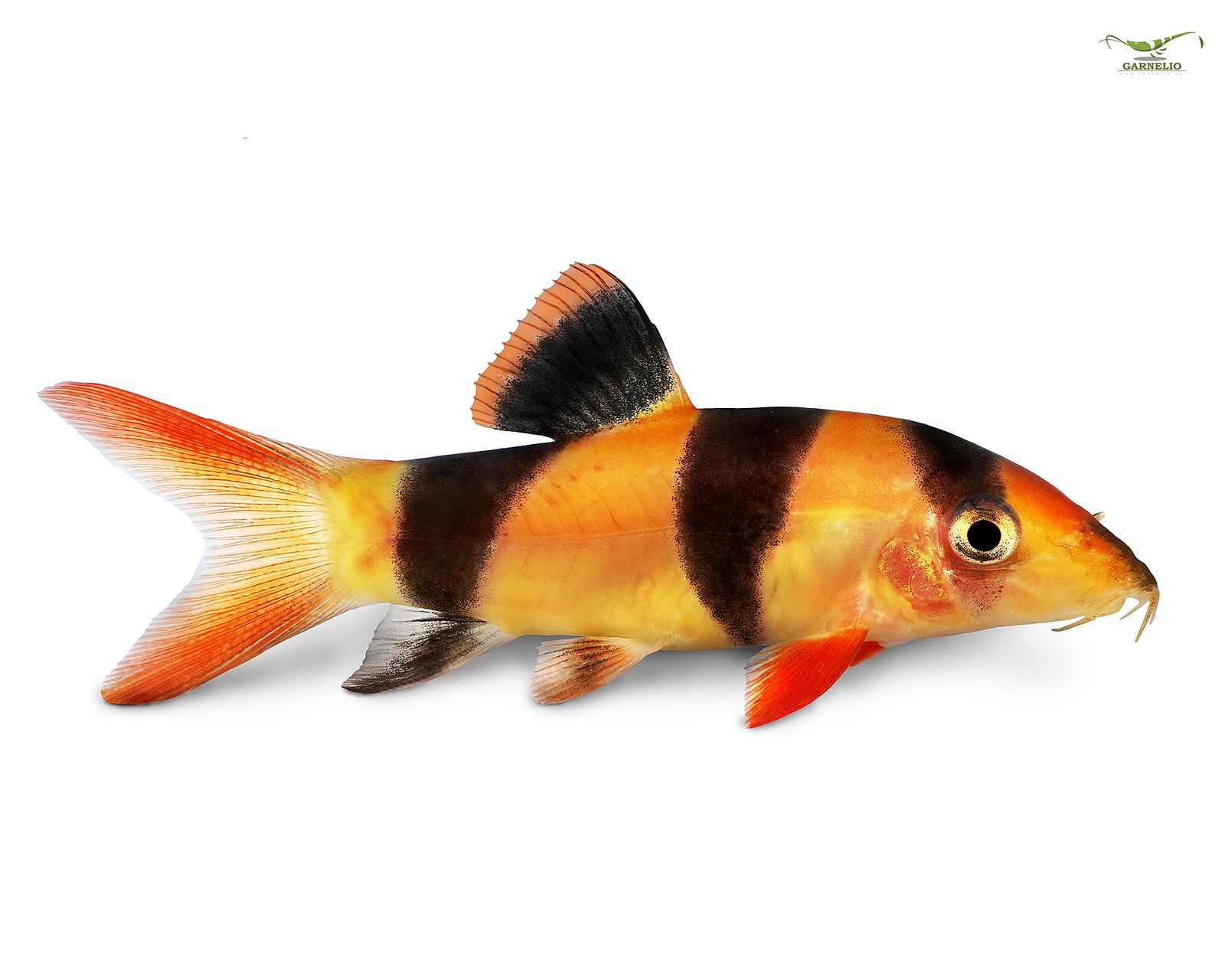
The Checkered Loach (Yasuhikotakia sidthimunki)(Shop)
The checkerboard loach with the unpronounceable scientific name, on the other hand, is a real alternative to the loach. With a body length of approx. 8-10 cm, it remains considerably smaller and can actually be kept in an aquarium as small as 80 cm. It is just as effective a snail eater as the much larger loach and thus definitely the better choice for beginners.
The checkerboard loach also has interesting social behaviour and should definitely only be kept in a group and never individually.

The Molly (Poecilia sphenops)(Shop)
Mollies are also a typical and often seen beginner's fish, especially the black Black Mollies are often seen - probably because there are not many completely black fish in aquaristics and because this colour is quite attractive and desirable. Mollies are livebearers and reproduce similarly well to platies and guppies. They tolerate medium-hard to very hard water and leave other medium-sized to large aquarium fish quite alone, so they are well suited for community aquariums with an edge length of 80 cm or more.
Mollies are not only available in black or silver, but also in many other colours, so that variety is guaranteed: golden-black gold dust mollies, silver-black Dalmatian mollies, completely silver or completely golden specimens, and golden-yellow mollies with larger black spots, the so-called leopard mollies. Many colour varieties are available with a normal tail fin or as Lyra Tail with extended fin tips.
The Sailfish (Poecilia velifera)(Shop)
For large aquariums with an edge length of 120 cm or more, there is an alternative to the Molly, which is often seen in aquariums: the Sailfish, which is closely related to the Molly and grows up to 18 cm long. With its strikingly large sail-shaped dorsal fin, it really causes a sensation and is as easy to keep and breed as the Molly.
Sailfish are also available in different colours, from gold, orange and blue-black patches to completely black. Like the closely related mollies, they like medium-hard to very hard water.
The fighting fish (Betta splendens)(Shop)
The sometimes very long, veil-like fins and also the great, intense colours have made the Betta splendens fighting fish famous from Asia. These beautiful fish no longer look like a wild fish at all, but have evolved into an art form. They can even be kept in aquariums without technical equipment and can be kept in cubes of 20 litres or more. Because they can be kept in soft to hard water and do not have many other needs besides meat and good planting, they are considered a good beginner's fish.
Breeding fighting fish is difficult, but keeping them is very easy and can be done even in a small nano aquarium. The only thing to keep in mind is that fighting fish are stress-prone loners and are therefore best kept individually without other fish. Two male fighting fish will fight each other to the death, and the ladies are often not much better behaved.
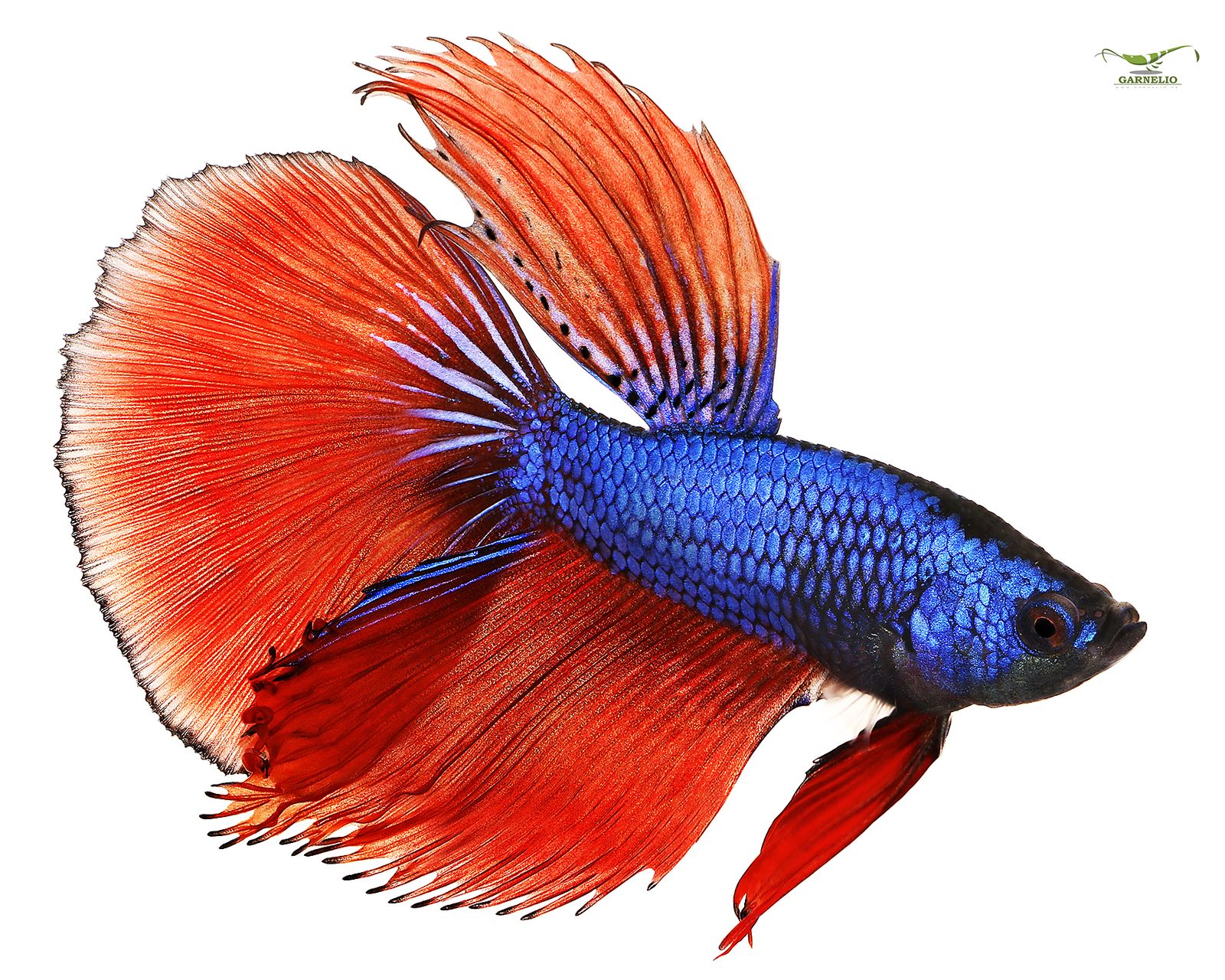
The Peaceful Fighting Fish (Betta imbellis)(Shop)
If you find the large-finned high-breeding fighting fish too overdone and mannered, if you don't really enjoy the bright, cultivated colours and if you prefer natural colours and shapes, the peaceful fighting fish is a good alternative to the Betta splendens. A pair of the rather peaceful Betta imbellis can be kept permanently in an aquarium with an edge length of 60 cm or more and will also breed there.
Like Betta splendens, the peaceful fighting fish is a pure carnivore.
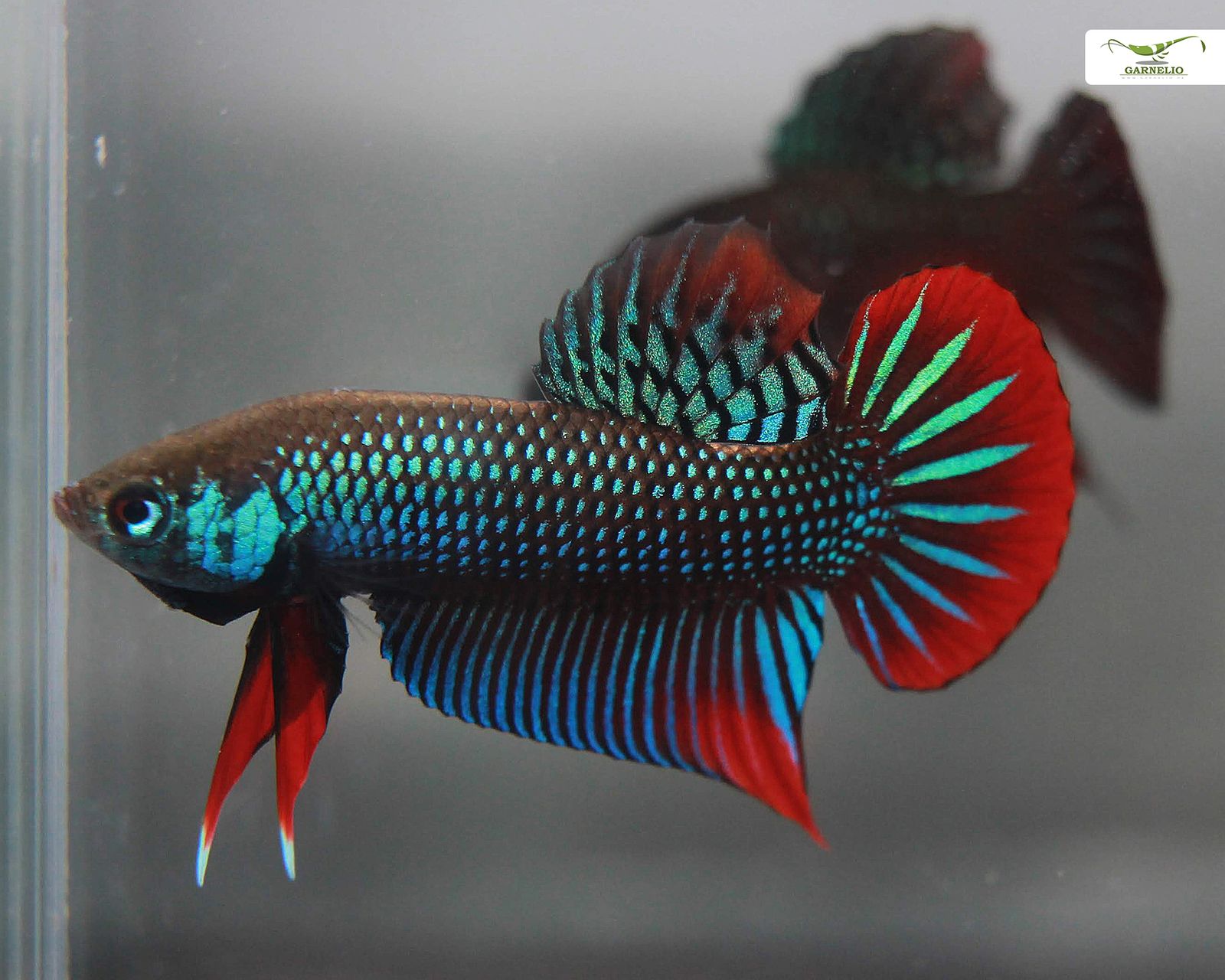
The Platy (Xiphophorus maculatus)(Shop)
Many, many colourful platies have been whetting the appetite for aquarists for a long time. They come in yellow, red, orange, blue, black, white, silver ... and in every conceivable combination. They even come with a panda pattern, in German colours, with an elongated tail fin, spotted, dotted, ... As robust, well-reproducing livebearers, they are also well suited for community tanks of 54 litres or more with rather hard water, and they are definitely an ornamental fish suitable for beginners, also and especially for planted aquariums. Platies even eat algae!
The colour combinations can be mixed, but if you want to sell them because of the strong reproduction, you should be aware that platies from mixed combinations are not easy to sell.
The Swordtail (Xiphophorus helleri)(Shop)
For a larger planted aquarium with an edge length of 80 cm or more and hard water, the swordtail, which is closely related to the platy, can be a nice alternative. This great ornamental fish is also available in a wide variety of colours and patterns, including a lyre form with elongated fins. The males stand out because of a very long extension of the lowest ray of their caudal fin, the eponymous sword, which makes the fish look much larger and even more impressive.
Swordtails are also long-established fish in aquaristics, ideal for beginners, but they are not quite as widespread as platies, precisely because they grow somewhat larger. You should make a choice between platy and swordtails - keeping the two closely related species in the same aquarium can lead to crossbreeding.
Finally
Even as a beginner you can be successful and have fun with your aquarium by choosing the right fish - if you pay attention to basic things like the space requirements of the animals, their demands on water and food and on the aquarium setup. Aquaristics is not witchcraft!
By the way, we have explained what you should consider before starting your hobby in our article "10 tips for budding aquarists".
By the way, in our Garnelio Blog article " The aquarium in the run-in phase " we explain what you should pay attention to during the run-in phase of the aquarium and when the fish and invertebrates can move in safely. If you take these really easy-to-implement tips into account, nothing will stand in the way of a smooth start to the hobby, and all that remains for us to do is to wish you lots of fun and welcome you to the big, colourful family of aquarists!
